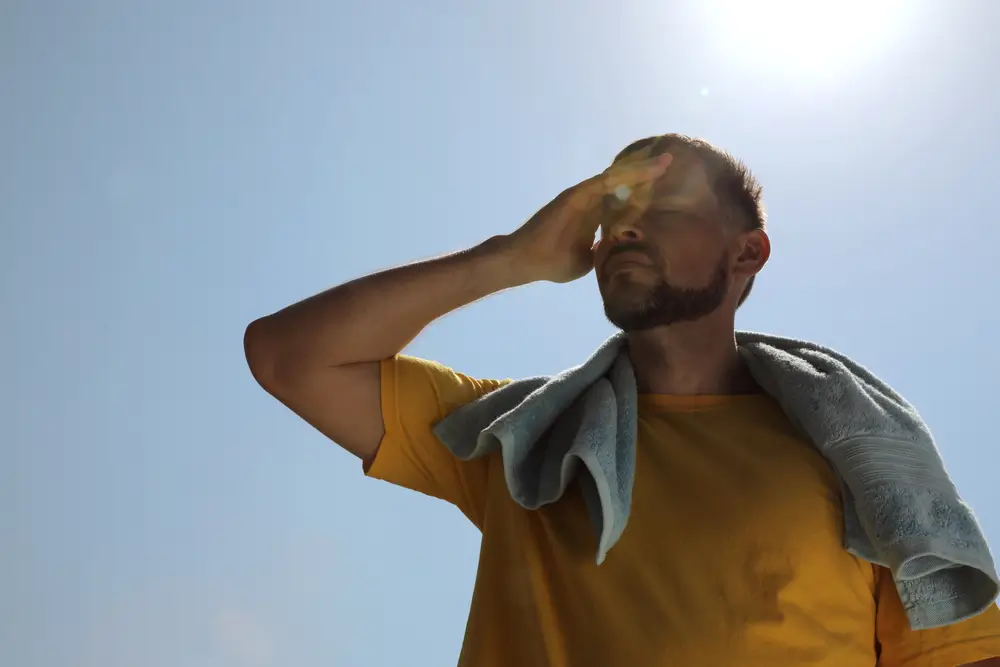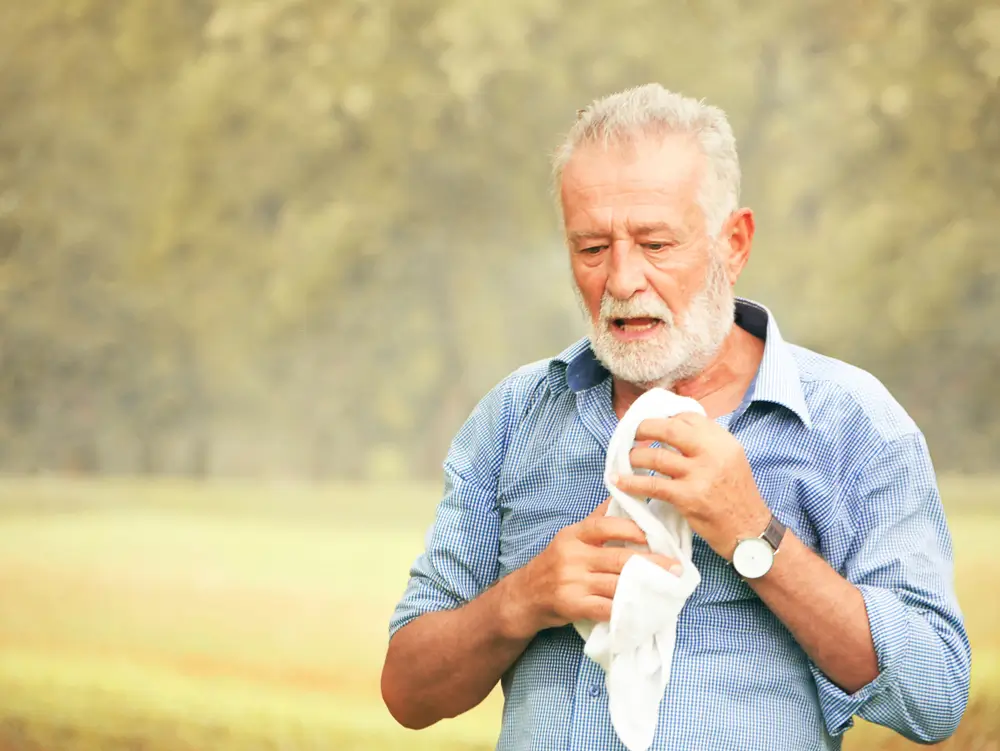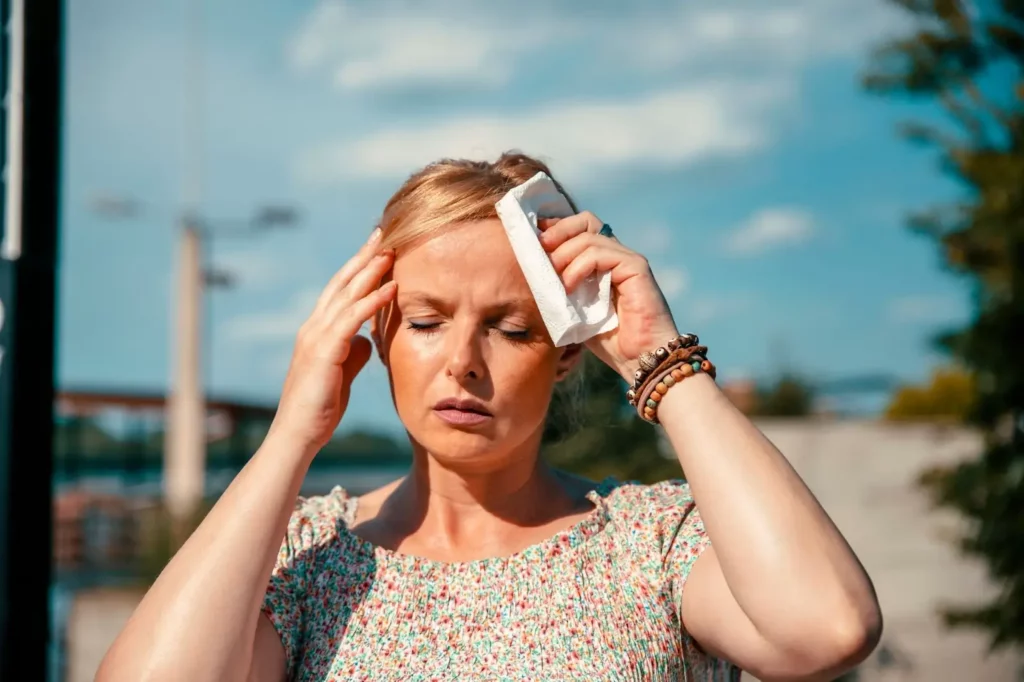Heatstroke is a severe condition caused by your body overheating, usually as a result of prolonged exposure to or physical exertion in high temperatures.
This most serious form of heat injury, heatstroke, can occur if your body temperature rises to 104 F (40 C) or higher. It requires emergency treatment and, if not treated in time, can quickly damage your brain, heart, kidneys, and muscles.
Understanding how to recognize and prevent heatstroke is crucial for maintaining your health and safety, especially during the hot summer months.
What is Heatstroke?
Heatstroke is an extreme form of hyperthermia that occurs when the body’s thermoregulatory system is overwhelmed by excessive heat. It is a life-threatening emergency that requires prompt action to cool the victim down and provide medical attention.
What Does a Heat Stroke Feel Like?
Symptoms of heatstroke can vary but often include throbbing headache, dizziness, muscle weakness or cramps, nausea, and a core body temperature above 104 F (40 C). Victims may also experience confusion, slurred speech, agitation, lack of sweating despite the heat, and unconsciousness.
What is the Cause of Heat Stroke?

The prevalence of heat-related illnesses, especially during the peak summer months, underscores the necessity for awareness and preventive measures. Individuals who are most vulnerable to heat stroke include the elderly, young children, individuals with chronic illnesses, and those who work or exercise outdoors.
Exposure to a Hot Environment
This occurs in conditions of high temperature and humidity, where the body’s ability to cool itself through sweating and evaporation is significantly diminished. Environments like saunas or desert climates can heighten the risk.
Strenuous Activity
Engaging in vigorous physical activities in warm climates increases body heat production, raising the risk of heatstroke. This is why athletes, military personnel, and construction workers are more susceptible to heatstroke during activities in hot weather.
What are the Signs of Heat Stroke?

Recognizing the signs of heatstroke is critical for providing timely treatment and preventing severe health complications or death.
High Body Temperature
A core body temperature of 104 F (40 C) or higher is the main sign of heatstroke and can be determined with a thermometer.
Altered Mental State or Behavior
Confusion, agitation, slurred speech, irritability, delirium, seizures, and coma can all indicate heatstroke.
Alteration in Sweating
In heatstroke caused by hot weather, your skin will feel hot and dry to the touch. However, in heatstroke brought on by strenuous exercise, the skin may feel moist.
Nausea and Vomiting
This symptom can indicate your body is struggling with the excessive heat and is a common sign of heatstroke.
Flushed Skin
Your skin may turn red as your body temperature increases.
Rapid Breathing
Breathing may become rapid and shallow as your body attempts to offload excess heat.
Racing Heart Rate
Your pulse may significantly increase because heat stress places a tremendous burden on your heart to help cool your body.
Headache
A throbbing headache is often one of the first signs of heatstroke. By understanding what heatstroke is, what causes it, how it feels, and its signs, individuals can take proactive steps to prevent this dangerous condition.
Always stay hydrated, wear lightweight clothing, and listen to your body’s warning signs during hot weather or when engaging in physical activity.
Who is Most at Risk for Heat Stroke?
Heat stroke represents the most severe form of heat-related illness, characterized by a body temperature of 104°F (40°C) or higher.
Those particularly vulnerable include the elderly, who may have compromised thermoregulation capabilities; young children, whose bodies heat up three to five times faster than adults; individuals with chronic diseases such as heart disease or diabetes; and outdoor workers or athletes who are exposed to the sun and heat for prolonged periods.
How to Avoid Heat Exhaustion and Heat Stroke

Preventing heat-related illnesses involves taking proactive steps to stay cool and hydrated. Here’s how:
1. Opt for Lightweight and Loose Clothing
Wearing light-colored, loose-fitting clothing helps your body cool down by enhancing heat evaporation.
2. Use Sun Protection
Sunburn affects your body’s ability to cool itself. Use a broad-spectrum sunscreen, wear a wide-brimmed hat, and seek shade whenever possible.
3. Hydrate Frequently
Staying hydrated is essential for maintaining a normal body temperature. Drink water consistently, even if you’re not thirsty.
4. Monitor Medication Effects
Some medications can exacerbate dehydration or impair the body’s heat response, requiring additional precautions.
5. Avoid Leaving Anyone in a Car
Temperatures in a parked car can rise rapidly to dangerous levels, posing a significant risk of heat-related illnesses.
6. Limit Exposure During Peak Heat
Schedule outdoor activities for cooler parts of the day, such as the early morning or late evening.
7. Adapt to the Environment
Allow your body to acclimate to heat by gradually increasing the time spent in warm environments.
8. Know Your Risk
Be extra cautious if you have a higher risk of heat-related illnesses due to age, underlying health conditions, or medication use.
When Should You Worry About Heat Stroke?
Immediate action is required when signs of heat stroke appear, such as confusion, rapid heartbeat, dizziness, nausea, heat stroke vomit, headache, or high body temperature. Heat stroke is a medical emergency that necessitates prompt treatment.
What are the Neurological Complications of Heat Stroke?
Heat stroke severity can lead to severe complications, including seizures, delirium, and even coma due to the brain’s sensitivity to high temperatures. These conditions require urgent medical attention.
FAQs
What Temp Causes Heat Stroke?
Reasons for heat stroke can occur when the body temperature rises above 104°F (40°C).
How Do You Know If You’re Having a Heat Stroke?
Symptoms include high body temperature, altered mental state or behavior, alteration in sweating, nausea, and flushed skin.
What Does a Heat Stroke Do to the Body?
It can damage the brain and other internal organs, potentially leading to serious complications or death if not treated immediately.
Is Vomiting a Sign of Heat Exhaustion?
Yes, vomiting and heat stroke can be related, indicating the body’s inability to cope with high temperatures.
Does Heat Increase the Risk of Heat Stroke?
Yes, high temperatures can strain the heart and blood vessels, potentially increasing the risk of stroke in vulnerable individuals.
Stay Safe and Hydrated
This summer, prioritize your health and safety by being mindful of the risks associated with heat. At Aether Health, we offer Summer IV Hydration and Vitamin Infusion, and Drug Detox Treatment to help you stay healthy and hydrated.
Remember, our 24/7 Emergency Room in Pearland, TX is always ready to provide you with immediate medical attention for heat-related illnesses and other emergencies such as recovering from heatstroke. For more information, visit our Emergency Room page. Stay safe and enjoy your summer responsibly!



